Getting a properly sized crate for your pet is key to providing them with a safe and comfortable place to rest and relax. However, with so many crates on the market, how do you ensure you select the perfect size? More importantly, “How to Size Dog Crates?“
In this article, we’ll walk you through the important considerations for sizing a dog crate and provide recommendations to help you pick the ideal option for your pet.
Choosing the right crate size requires knowing your dog’s height, length, and weight. It also means taking into account factors like their age, breed, and activity level. An appropriately sized crate allows your dog enough room to stand up, turn around, and lie down comfortably, without excessive extra space.
Whether you are crate training a new puppy or looking for an upgrade for your adult dog, you’ll find the tips and guidelines you need to select a crate that provides your dog safety, security, and comfort.
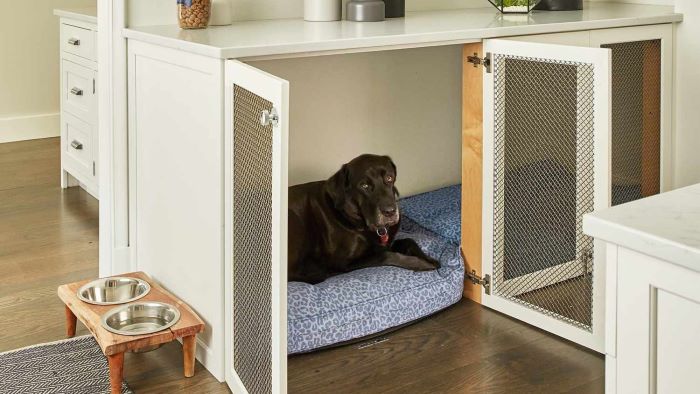
Measuring Your Dog for a Crate
Finding the ideal crate for your dog starts with taking a few key measurements so you can get one that fits them just right.
First up is measuring their height. You’ll want to measure them from the floor to the highest point of their shoulders while they are standing normally. Don’t have them scrunch down or stretched upwards – just a natural standing position. Use a measuring tape and bend down to eye level to get it just right. Mark down the measurement to the nearest inch or half inch.
Next, you’ll need to measure their length – this is how much they need to fully stretch out for napping. You can have them sit or lie down, then run the measuring tape from the tip of the nose back to the tail. Again, round up to the nearest inch or half inch.
You’ll also want to know your dog’s weight. This helps make sure the crate is sturdy enough to hold them safely. Stepping on the scale while you hold them works great.
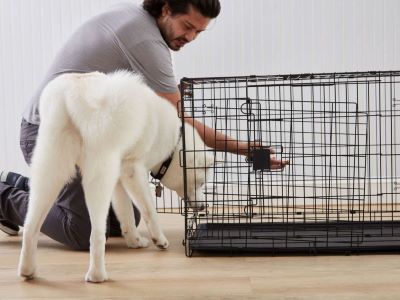
While you’re at it, look up the average height and weight of your dog’s breed. Each breed varies, so this gives you a general idea of what size they typically are. Your measurements are the most important part of the whole process.
Also factor in if your dog is a young energetic pup who likes to play and bounce around or an older calmer dog who likes napping more. Active dogs usually like a little more wiggle room.
Once you’ve got all the measurements plus your dog’s age and energy, you’ll know the perfect crate size to give them space to stand up, turn around, and sleep soundly. It’s important to get it right so they can settle in and enjoy their new crate![1]
Crate Sizing Guidelines

When it comes to getting just the right-sized crate for your dog, there are some helpful guidelines to keep in mind. The size you need can also depend on your dog’s age.
For a young growing puppy, you’ll want to create that gives them some extra room. Puppies grow fast, so you’ll need a crate you can size up quickly. Look for crates with adjustable dividers or plan on buying a bigger replacement crate as your puppy grows.
For adult dogs, the ideal crate allows them to stand up without having to scrunch down. They should also be able to turn around completely and lie down flat on their side to sleep. Too much extra space isn’t good though – your dog will feel more stressed and be more likely to have accidents.
If you have an extra large or giant breed, you may need to look into extra or XXL-sized crates. The bigger bodies need more room to stretch out. You can also make custom crates if needed.
Some key things to keep in mind for any dog are:
- You should measure your actual dog since the sizes may vary even within breeds.
- Add 2-4 inches beyond their measurements for wire crates.
- A sturdy plastic airline crate should match your dog’s size exactly.
- Active energetic dogs usually appreciate more space.
- Senior dogs are happy with a cosier enclosure.[2]
Selecting Crate Type
Selecting a crate type becomes a crucial part if you’re not making it tailored for your pet as per its requirements and needs. But here, you get plenty of options. Now it all comes down to how space-friendly you want the crate to be or if your needs are for travelling along with your pet. So, “How to size dog crates?“
Here’s a bit about the most common crate types that can help you to choose:
1. Wire Crates:
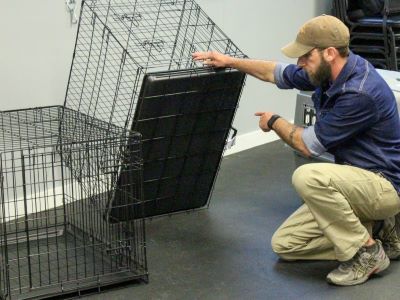
Wire Crates are classic metal cages that fold up nicely when not in use. They provide great ventilation and visibility for your dog. Wire crates are easy to clean – just wipe or hose them out. Its sizing can be adjustable with removable divider panels. The downside is they aren’t as sturdy for travel.
2. Heavy-Duty Plastic Crates:
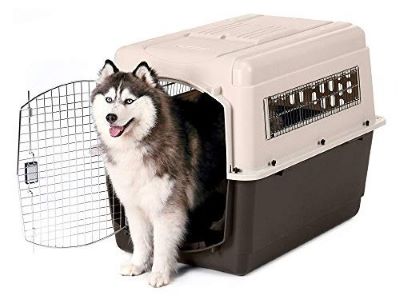
Heavy-duty plastic airline crates are ideal for on-the-go dogs. These hard-sided kennels meet airline cargo specifications for flying or shipping pets. They provide privacy, and protection, and retain heat well. Proper ventilation is an important factor here. Be sure to get accurate measurements as sizing needs to be precise.
3. Soft-Sided Crates:
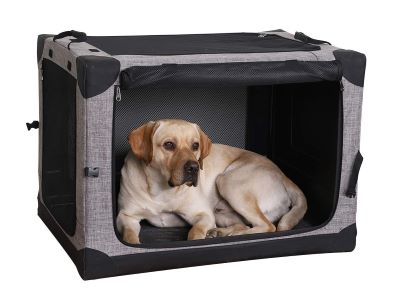
For travel convenience, soft-sided crates are lightweight and collapse for storage. They aren’t as durable or protective as rigid models. Best for short trips or small dogs. It ensures the fabric supports your dog’s weight and the mesh panels allow airflow.
Beyond the main options, consider material, special features, colours, etc. For anxious dogs, try darkened crates to feel more den-like Expandable crates accommodate growing puppies. If going custom, add your dog’s name or fun patterns!
Additional Crate Sizing Tips
Doing all the measurements of your dog and overlooking basic sizing guidelines will easily let you decide on “How to Size Dog Crates?“. Picking an ideal crate for your growing puppy can be difficult, but there are just a few additional crate sizing tips that can help you with your choices. Here are some tips:
- Have your dog stand, sit, and lie down in their natural positions when taking measurements. No scrunching or stretching!
- Account for bedding if using a crate mat or comfy dog bed inside. They take up space so your dog still has room to move.
- Consider potential growth if your puppy is very young. It’s a good idea to size up just in case.
- Make sure you can easily access the crate door and interior for cleaning. You don’t want to struggle to reach inside.
- Pick a crate location with plenty of ventilation and temperature control. This keeps your dog comfy.
- Set up the crate and test it out before officially introducing your dog to it. Adjust sizing if needed.
- Use crate dividers to initially limit space for young puppies or rescue dogs feeling overwhelmed.
- If travelling, ensure the crate isn’t too big to fit in your vehicle. Don’t squish your dog.
FAQs
How to Size Dog Crates?
Start by measuring your dog’s height, length, and weight. Check their breed’s size chart too. Use those numbers to find a crate big enough for them to stand, turn, and lie down comfortably. But not too big – you don’t want extra space.
Should I get a bigger crate so my puppy can grow into it?
Yes, it’s a good idea to plan if your puppy is still young and growing. Start with a crate that gives them just enough extra room and size up as they get bigger. You can also use divider panels to adjust the space.
What if I have a really large breed dog?
No problem! They make extra and XXL-sized crates for big dogs. Measure your giant breed pup carefully and you can usually find an oversized crate to fit their needs. Custom crates are another option.
How much space should be around my dog in their crate?
You want just enough room for them to stand fully, turn around easily, and lie down flat. They shouldn’t be cramped but extra space can be stressful. Follow measurement guidelines based on crate type.
Should I put bedding or mats in the crate?
Yes, crate mats and comfy crate-safe beds make the space cosier. Just be sure to account for the extra inches they take up when sizing the crate. You still want your dog to have the full range of movement.
Conclusion
Finding the perfect-sized crate for your dog is really important for their comfort and happiness. The right-sized crate lets them stand up, lie down, and turn around without being cramped up. You can measure your dog using various crate sizing guides available, or you can get a crate custom-made for them as per their needs and your desired styles.
You always have to make sure to get their height, length, and weight, and also check their breed’s size and information. Also, think about their age and energy level – active dogs and puppies often like more space, whereas lazy dogs seek cosiness. Use a crate with dividers to adjust the sizing and needs as your puppy grows.
Apart from asking questions like “How to size dog crates?“, you should know that having a properly fitted crate will help your dog feel safe and secure. It also makes training them inside the house easier since there is no chance of making mistakes. Your dog will enjoy having the special crate that you’ve picked for them.
References:
- How to Choose the Best Crate for Your Dog | American Kennel Club
- Finding the Right Crate Size for Your Dog | Petco



